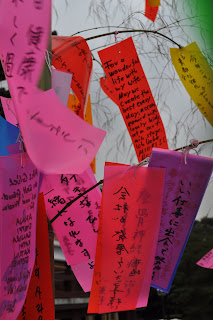 Our hotel in Tokyo wasn't too far from the Zojo-ji, the family temple of the Tokogawa samurai clan dating back to the early 16th century. When we had some free time, my friend Susan and I went to see the temple. First we turned the corner and entered the temple complex through the San-gadatsu-mon, the 21-metre-high wooden gate, the oldest wooden structure in Tokyo, dating from 1612. (Depsite its history and size, it's easy to "miss" this wonder because it lies in the middle of a major Tokyo intersection and is lost all the business of a major metropolitan city). We made our way to the temple's main hall.
Our hotel in Tokyo wasn't too far from the Zojo-ji, the family temple of the Tokogawa samurai clan dating back to the early 16th century. When we had some free time, my friend Susan and I went to see the temple. First we turned the corner and entered the temple complex through the San-gadatsu-mon, the 21-metre-high wooden gate, the oldest wooden structure in Tokyo, dating from 1612. (Depsite its history and size, it's easy to "miss" this wonder because it lies in the middle of a major Tokyo intersection and is lost all the business of a major metropolitan city). We made our way to the temple's main hall. We happened to come to the temple as they were getting ready for one of Japan's major traditional festivals-the Tanabata Mitsuri. The festival is also known as the star festival and it takes place on the 7th day of the 7th month of the year. The festival is based on a Chinese legend about the love story of the two stars Orihime (Vega) and Hikoboshi (Altair). As the story goes, a weaver girl falls in love a farmer boy, but their love is disapproved of by the Goddess of Heaven. As a punishment they are separated by the Milky Way and can only meet once a year on this night. The Japanese celebrate this day by wearing yukata (casual kimono) and decorating bamboo trees. Susan and I wrote our wishes on a piece of colored paper and hung them, along with the wishes of hundreds of others on a specially erected bamboo tree in hopes that the wishes become true. The bamboo trees were later burned to allow our wishes to reach the heavens.
After hanging our wishes, we then walked off to the side of the main hall to the cemetary where we walked pass hundreds of jizo statues, gurdians of children, travelers, and women. Each jizo is covered with a red bonnets and decorated with small momentos in remembrance of a deceased infant or unborn child.
 That night Susan and I climbed the Tokyo Tower. The tower was opened in 1958 and was built to resemble the Eiffel Tower. Up on the observation deck we got a spectacular view of city at night. We also saw many families and couples dressed in their yukatas, enjoying an evening together, while enjoying the view.
That night Susan and I climbed the Tokyo Tower. The tower was opened in 1958 and was built to resemble the Eiffel Tower. Up on the observation deck we got a spectacular view of city at night. We also saw many families and couples dressed in their yukatas, enjoying an evening together, while enjoying the view. 















.JPG)

